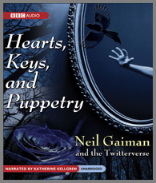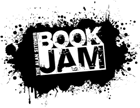 [UPDATE 2009/12/23: View a video of Katherine Kellgren narrating the audiobook.] Continuing with the Gaiman news, beginning at noon on Tuesday, October 13, BBC Audiobooks America started an intriguing experiment: Creating a book and audiobook via twitter. It started with one tweet and 140 characters from Neil Gaiman:
[UPDATE 2009/12/23: View a video of Katherine Kellgren narrating the audiobook.] Continuing with the Gaiman news, beginning at noon on Tuesday, October 13, BBC Audiobooks America started an intriguing experiment: Creating a book and audiobook via twitter. It started with one tweet and 140 characters from Neil Gaiman:
@neilhimself: Sam was brushing her hair when the girl in the mirror put down the hairbrush, smiled & said, “We don’t love you anymore.”
From there, followers of the hashtag on twitter could read along and contribute their own 140 character sentences to the story. What emerged was a story about a young girl who made a deal with the dark side to save a loved one, and who is thrown into a world she doesn’t understand to try and right her mistake. The work, titled (via an online vote) Hearts, Keys, and Puppetry, was turned into an audiobook narrated by frequent Recorded Books narrator Katherine Kellgren and is now available for download.
The work is the first of its kind and definitely worth a listen. It’s very interesting to see the direction the work took. Though Gaiman’s first sentence could have led in multiple directions, the story clearly uses tropes from fantasy and fairy tale genres. It would be interesting to try this experiment again to see other directions the multiple authors could lead the story into.
This is also an experiment that you could easily do in your classroom. Though many of you may have already done group writing projects, writing in such short segments and then recording the audio afterward adds another dimension—writers would have to pay closer attention to flow, voice, tone, and how their phrasing will sound when read aloud. If anyone takes up this project in their classroom, let us know—we’d love to hear the results!
Download from BBC Audiobooks America here.
Download via iTunes podcast here.
Filed under: Audiobooks and Education | Tagged: audiobooks, writing | Leave a comment »




















